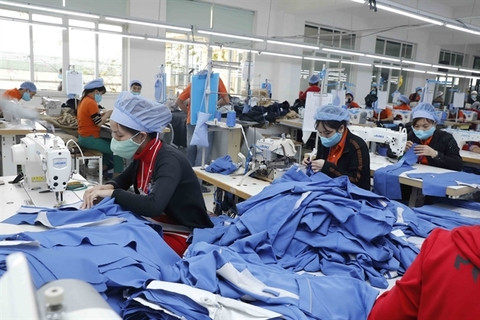
A garment factory in Hưng Yên. Việt Nam’s exports are set to recover in Q4, driven primarily by a bottoming out of the US inventory cycle, but also by an acceleration in the relocation of manufacturing from China to Việt Nam. — VNA/VNS Photo Trần Việt
Việt Nam’s exports are set to recover in Q4, driven primarily by a bottoming out of the US inventory cycle, but also by an acceleration in the relocation of manufacturing from China to Việt Nam, according to Michael Kokalari, chief economist at VinaCapital.
The US is Việt Nam’s biggest export market, accounting for about one-quarter of its total exports, but its exports to the market fell by more than 20 per cent yoy in the first seven months.
US retailers and other consumer product companies bought too many “Made in Vietnam/Made in Asia” products last year in anticipation of a post-COVID re-opening boom. But instead of buying more manufactured products when COVID lockdowns lifted, US consumers splashed out on services like travel and going out to eat. These have resulted in the inventories of companies like Walmart, Target, and Nike ballooned by over 20 per cent yoy in late-2022.
US retailers slashed orders at factories in Việt Nam this year in response to their bloated inventories, which explains why Việt Nam’s exports to the US fell.
US firms have been aggressively de-stocking throughout 2023 and the ISM’s Inventory Sub-Index hit a nine-year low in June and bounced slightly in July, suggesting that the rate of inventory depletion has hit bottom.
“The aggressive inventory reduction efforts of firms like Walmart and others drove the plunge in Việt Nam’s exports in H1, but that destocking is now approaching its conclusion, and Việt Nam’s exports to the US increased by nearly 7 per cent month-on-month in July. Consequently, the year-on-year decline in Việt Nam’s exports to the US improved from a 26 per cent yoy drop in June to a 14 per cent yoy decline in July, which helped reduce the fall in Việt Nam’s total exports from 12 per cent yoy in H1 to 2 per cent yoy in July,” he said.
In addition to a cyclical recovery in exports to the US, Việt Nam is also benefitting from companies moving their production from China to Việt Nam, which helps explain why Việt Nam’s exports fell 2 per cent yoy in July versus a 15 per cent yoy drop in China, a 16 per cent drop in Korea, and a 10 per cent decline in Taiwan.
“All Asian exporters should be benefitting to some degree from a de-stocking-driven export recovery, but Việt Nam is the only country in Asia that is also significantly benefitting from the establishment of new factories in the country. Related to this is the fact that FDI inflows to China hit a record low in Q2.”
Sustainable export rebound
Kokalari said the improvement in Việt Nam’s exports will accelerate as 2023 progresses based on several reliable leading indicators, including Việt Nam’s import growth finally caught up to export growth on a sequential basis in July, after having lagged significantly for much of 2023, the ongoing decline in export orders for Việt Nam’s factories finally eased in July, and firms’ inventories of raw materials increased in July for the first time since late-2022.
The decline in firms’ export orders moderated significantly last month and factory output grew 4 per cent month-on-month in July, both of which helped push Việt Nam’s PMI up from 46.2 in June to 48.7 in July.
“We believe firms are ramping up their imports/purchases of raw materials in anticipation of a resurgence of factory orders later this year.
Consumer electronics, smartphones and garments will drive export recovery, he said.
Speaking to the media recently, Phạm Tùng Linh, deputy general director of Đức Giang Corporation, one of the leading garment and textile firms in Việt Nam, said the market has shown positive signs since the third quarter of the year, with a return of export orders, especially from the US and EU markets.
His company has orders to the end of 2023 and is looking for orders for 2024, he said.
Việt Nam ranked among the world’s largest wooden furniture exporters. And a preliminary survey by the Handicraft and Wood Industry Association of HCM City found that export orders of enterprises in the industry began to recover in July ahead of the global year-end furniture shopping season.
“We expect a full recovery in Việt Nam’s exports and manufacturing activity next year (back to 8-9 per cent growth for manufacturing), which will in-turn drive a recovery in the country’s GDP growth from below 5 per cent in 2023 to 6.5 per cent in 2024,” Kokalari said, adding that recent Government measures to support the country’s economy, including policy rate cuts, will also support Việt Nam’s economic growth next year.
The export-driven recovery in Việt Nam’s economy should help propel an increase in the earnings growth of the VN-Index from 6 per cent in 2023 to over 20 per cent in 2024, which should support the VNI in the months ahead, he added. — VNS